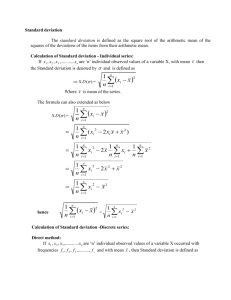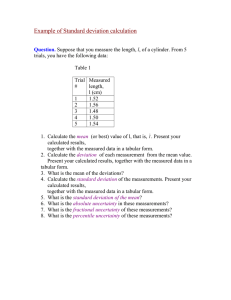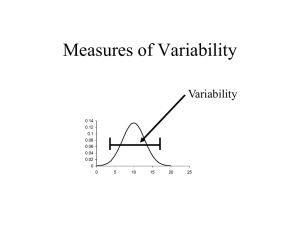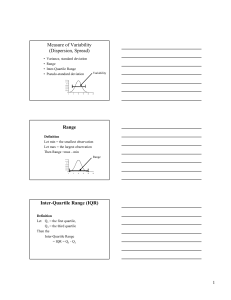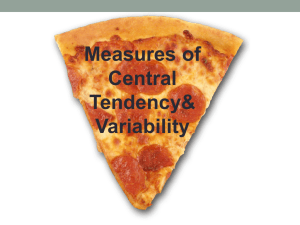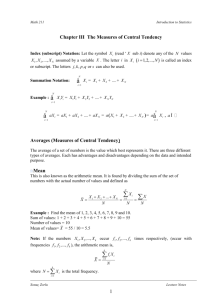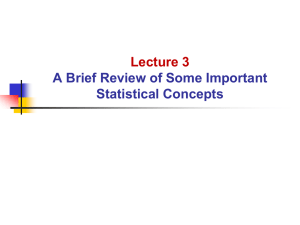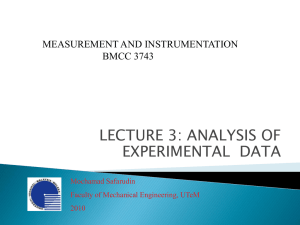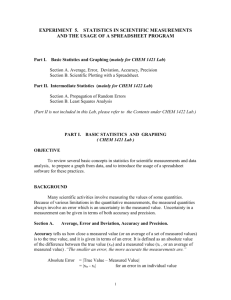Frequency table calculations Use your calculator to
advertisement
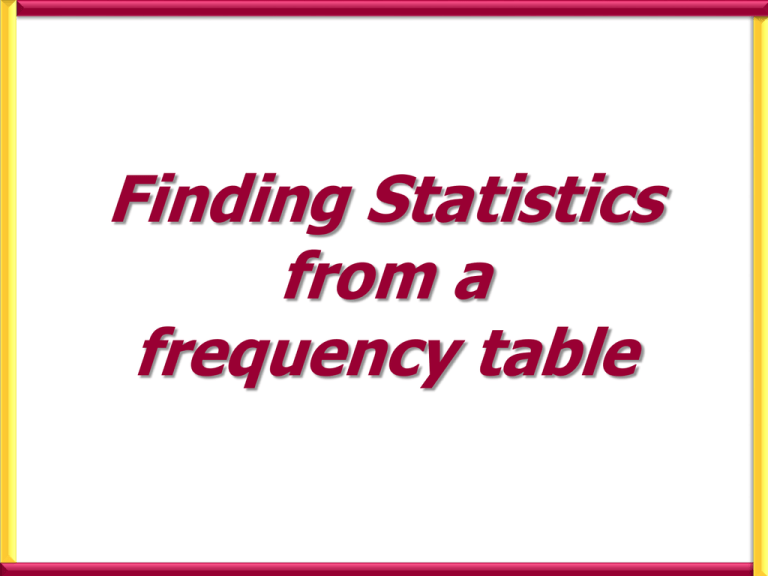
Finding Statistics
from a
frequency table
1 person rolled a di 50
times and recorded
their rolls.
Number
Frequency
1
8
2
7
3
13
4
4
5
11
6
7
Find the
(i) Min
(ii) Max
(iii) Range
(iv) Mean
(v) Standard Deviation
from the calculator
We first need to make
sure the calculator is
CLeaR
of all previous content
1 person rolled a di 50
times and recorded
their rolls.
Number
Frequency
1
8
2
7
3
13
4
4
5
11
6
7
Find the
(i) Min
(ii) Max
(iii) Range
(iv) Mean
(v) Standard Deviation
from the calculator
We first need to make
sure the calculator is
CLeaR
of all previous content
3: All
Yes
Reset All
1 person rolled a di 50
times and recorded
their rolls.
Number
Frequency
1
8
2
7
3
13
4
4
5
11
6
7
Find the
(i) Min
(ii) Max
(iii) Range
(iv) Mean
(v) Standard Deviation
from the calculator
We need to SETUP the
calculator to allow us to
input
Stat with frequency ON
1 person rolled a di 50
times and recorded
their rolls.
Number
Frequency
1
8
2
7
3
13
4
4
5
11
6
7
Find the
(i) Min
(ii) Max
(iii) Range
(iv) Mean
(v) Standard Deviation
from the calculator
Statistical and
Regression
Calculations
Put the calculator
into STAT mode
1 person rolled a di 50
times and recorded
their rolls.
Number
Frequency
1
8
2
7
3
13
4
4
5
11
6
7
Find the
(i) Min
(ii) Max
(iii) Range
(iv) Mean
(v) Standard Deviation
from the calculator
We only have 1 variable so
Select
Enter the number column
first pressing
after each one.
(the frequency automatically sets to 1)
Go to the top of the next
column
Enter each frequency
pressing
After each one
Once they have all been
entered press
1 person rolled a di 50
times and recorded
their rolls.
Number
Frequency
1
8
2
7
3
13
4
4
5
11
6
7
Find the
(i) Min
(ii) Max
(iii) Range
(iv) Mean
(v) Standard Deviation
from the calculator
We now need to
analyse the statistics
we have input
1 person rolled a di 50
1:
Typeand recorded
times
their rolls.
change the type of data
Number
Frequency
2: Data
Edit the data
1
8
3: Sum
4: Var
2
7
3
13
1: How many terms
4
4
2: Mean of data
5: Min5 and max11of x
3: Population Standard
6
7
Deviation
Find the
4: Sample Standard
(i) Min
Deviation
(ii) Max
(iii) Range
(iv) Mean
(v) Standard Deviation
Once you have chosen your required output you need to press
from the calculator
1 person rolled a di 50
times and recorded
their rolls.
Number
Frequency
1
8
2
7
3
13
4
4
5
11
6
7
Find the
(i) Min
(ii) Max
(iii) Range
(iv) Mean
(v) Standard Deviation
from the calculator
(i) Min
=0
(ii) Max
=6
(iii) Range
= 6–0
=6
(iv) Mean
(i)
= 3.48
Standard Deviation
= 1.66
E.g 1 The frequency table of the monthly salaries of 20 people
is shown below.
salary(in €)
3500
4000
4200
4300
frequency
5
8
5
2
a) Calculate the mean of the salaries of the 20 people.
b) Calculate the standard deviation of the salaries of the 20
people.
E.g 2. The following table shows the grouped data,
in classes, for the heights of 50 people.
height (in cm) - classes
120 ≤ 𝒉 < 130
130 ≤ 𝒉 < 140
140 ≤ 𝒉 < 150
150≤ 𝒉 < 160
160 ≤ 𝒉 < 170
frequency
2
5
25
10
8
a) Calculate the mean of the salaries of the 20 people.
b) Calculate the standard deviation of the salaries of
the 20 people
E.g3. Consider the following three data sets A, B and C.
A = {9,10,11,7,13}
B = {10,10,10,10,10}
C = {1,1,10,19,19}
a) Calculate the mean of each data set.
b) Calculate the standard deviation of each data set.
c) Which set has the largest standard deviation?
d) Is it possible to answer question c) without
calculations of the standard deviation?
E.g 4.A given data set has a mean μ and a standard deviation σ.
a) What are the new values of the mean and the standard
deviation if the same constant k is added to each data
value in the given set? Explain.
b) What are the new values of the mean and the standard
deviation if each data value of the set is multiplied by
the same constant k? Explain.
E.g 5 If the standard deviation of a given data set is equal to
zero, what can we say about the data values included in
the given data set?
